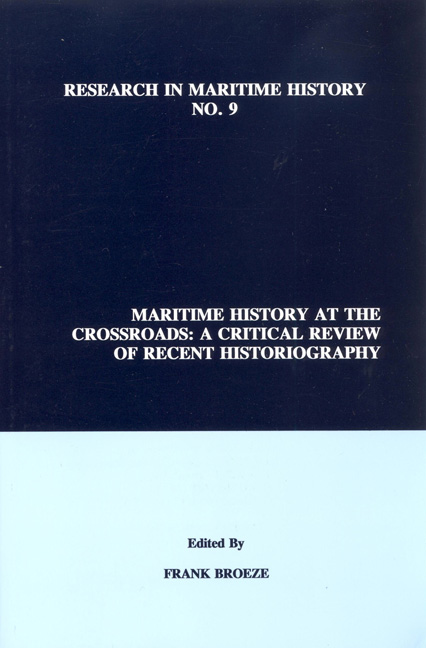Book contents
- Frontmatter
- Contents
- About the Editor
- Introduction
- Contributors
- “Maritime History in Australia”
- “The Enterprising Canadians: An Assessment of Canadian Maritime History since 1975”
- “The Historiography of Maritime China since c. 1975”
- “Danish Maritime History, 1976-1992: A Review”
- “German Maritime Historical Research since 1970: A Critical Survey”
- “The Maritime Historiography of Greece in Recent Decades”
- “Ibero-American Maritime History: Recent Advances in Research, 1975-1994”
- “Indian Maritime Historiography: West Coast Merchants in a Globalizing Economy”
- “Recent Developments in the Historiography of Maritime History in the Netherlands”
- “The Ottoman Empire: Recent Research on Shipping and Shipbuilding in the Sixteenth to Nineteenth Centuries”
- “The Progress of Maritime History in Spain since 1975”
- “Oceanic Historiography: The American Dimension”
“Maritime History in Australia”
from Contributors
- Frontmatter
- Contents
- About the Editor
- Introduction
- Contributors
- “Maritime History in Australia”
- “The Enterprising Canadians: An Assessment of Canadian Maritime History since 1975”
- “The Historiography of Maritime China since c. 1975”
- “Danish Maritime History, 1976-1992: A Review”
- “German Maritime Historical Research since 1970: A Critical Survey”
- “The Maritime Historiography of Greece in Recent Decades”
- “Ibero-American Maritime History: Recent Advances in Research, 1975-1994”
- “Indian Maritime Historiography: West Coast Merchants in a Globalizing Economy”
- “Recent Developments in the Historiography of Maritime History in the Netherlands”
- “The Ottoman Empire: Recent Research on Shipping and Shipbuilding in the Sixteenth to Nineteenth Centuries”
- “The Progress of Maritime History in Spain since 1975”
- “Oceanic Historiography: The American Dimension”
Summary
Introduction
Australia is the world's largest island, covering a vast area of 7.68 million square kilometres. The coastline is about 36,735 km. in length and, since the declaration of an exclusive 200-mile fishing zone in 1979, Australia has controlled a fishing zone of about 8.94 million square km. In short, geography and political and legal actions have determined that Australia is a maritime nation with access to extensive marine resources.
Although about ninety percent of Australians live within fifty kilometres of the sea and devote a considerable amount of leisure time to maritime pursuits, “in Australia, we have a beach culture, but not yet a sea culture.” Historians, in their search for what Russel Ward has termed “the Australian Legend,” have traditionally focused on the development of the interior and neglected Australia's maritime heritage. In the last two decades there has, however, been an upsurge of both public and academic interest in maritime heritage, reflected in such events as the formation of the Australian Association for Maritime History in 1978, the celebrations following Australia's victory in the America's Cup Races in September 1983, and the arrival of a fleet of “Tall Ships” in Sydney Harbour on January 26, 1988 as part of the bicentenary celebrations. The progress of Australian maritime history was surveyed in two papers, one by Malcolm Tuli in 1988 and another by Frank Broeze in 1989. Both Tuli and Broeze discussed the reasons for the relatively low profile of maritime history and “the malaise in which maritime history has found itself for a long time. “ They drew attention to important landmarks in the development of maritime history, such as Geoffrey Blainey's The Tyranny of Distance (1966) and John Bach's A Maritime History of Australia (1976). Tuli was relatively optimistic about the prospects for maritime history, but Broeze, while recognising the growing interest in maritime history and heritage, argued that bringing “it from the periphery into the mainstream” remained a major challenge.
- Type
- Chapter
- Information
- Maritime History at the CrossroadsA Critical Review of Recent Historiography, pp. 1 - 30Publisher: Liverpool University PressPrint publication year: 1995



